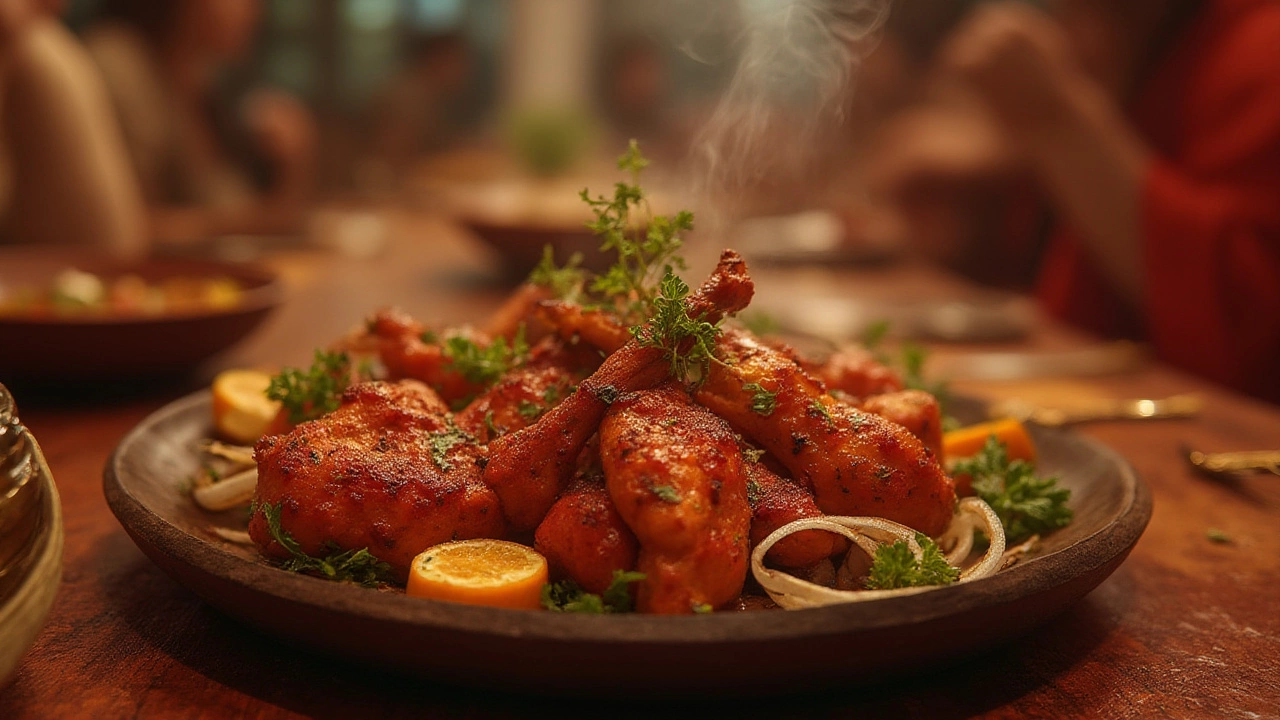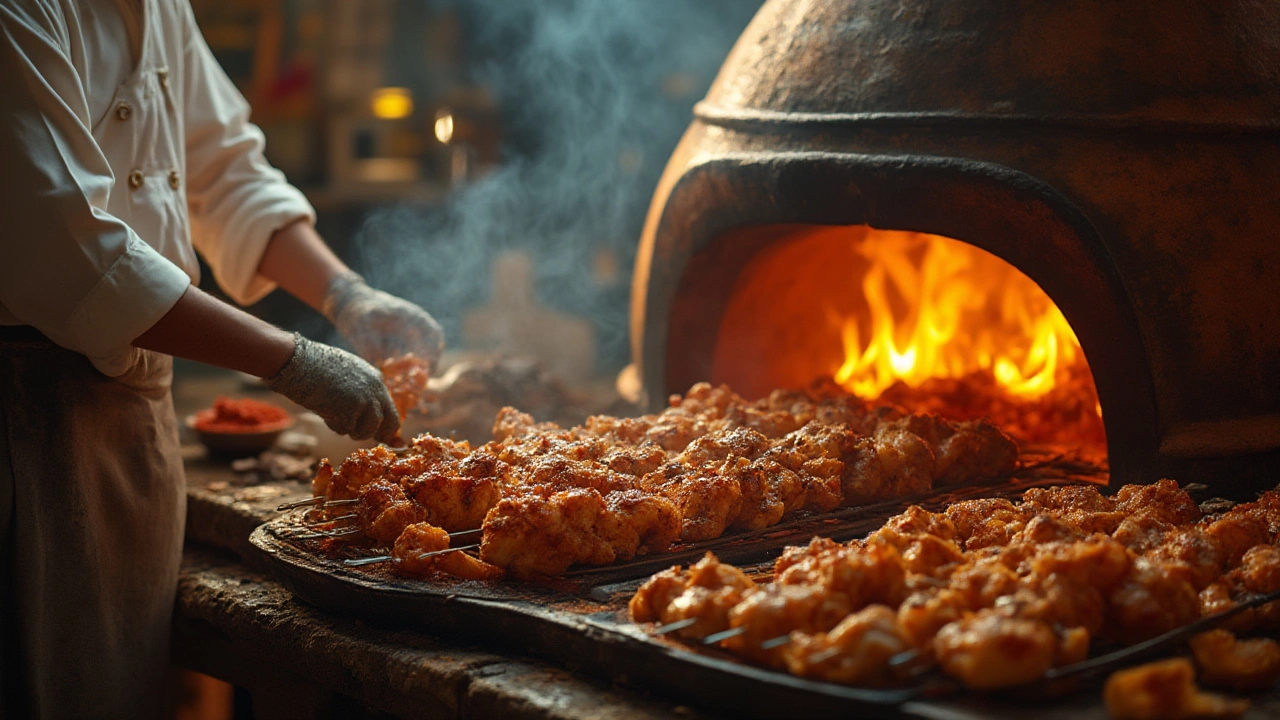31 Jul 2025
- 0 Comments
Some folks see that blazing red tandoori chicken and instantly wonder: is it actually fried? It's such a vivid, charred, almost fiery dish, it’s hard not to assume there’s a deep fryer hiding somewhere behind the kitchen door. But here’s where things get surprising—tandoori chicken isn’t fried at all. Its secret lies in a centuries-old grilling technique and a seriously hot clay oven. The confusion isn’t new, especially with so many versions out there (we’ve all seen something labeled "tandoori" that’s a bit too oily, right?). But the truth is, that smoky, slightly blackened surface comes from pure, open flame grilling—never a bubbling vat of oil. Ready for all the real details (and a few surprising tips) about how tandoori chicken is truly made?
How Authentic Tandoori Chicken Is Made: Fire, Clay, and Tradition
If you peek into the kitchen of a proper North Indian restaurant, you’re not going to spot a fryer. The action happens around something called a tandoor—a huge barrel-shaped oven made from clay. That’s where tandoori chicken gets its name, and honestly, all its magic. Imagine a backyard grill that burns four or five times hotter, uses real wood or charcoal for flavor, and has sides that hit nearly 800°F (about 425°C). That’s hotter than a pizza oven! It’s so intense, you can actually feel the heat a few feet away.
The preparation always starts with the marinade. Bone-in chicken (usually legs and thighs, but sometimes even a whole bird) is slashed with a knife to help flavors soak in. Then it takes a luxurious bath in thick yogurt, mixed with spices like cumin, coriander, garam masala, and plenty of chili powder—hence that eye-popping red color. Sometimes natural colors like beetroot or Kashmiri chili go in, but these days you might see food coloring too for that firetruck-bright look. Yogurt is the real hero here—besides making the bird tender and juicy, it holds onto all the spices and lets them seep deep into the meat.
The tandoor oven is fired up, and when it’s searing hot, skewer after skewer of marinated chicken is slid vertically inside. The chicken doesn’t touch the actual flames or the coals, but hangs, cooking in the dry furious heat, almost like a turbo-powered rotisserie. That’s where the famous char develops—the kind you’d only get from grilling, not frying. Frying uses fat and covers the entire surface in oil; tandoori chicken is all about dry, fast heat. That’s why, if you take a bite, you get those smoky edges, but the flavors inside are all vivid and fresh.
This method isn’t some modern chef’s invention. The tandoor dates back over 5,000 years (archaeologists found ancient ones in the Indus Valley civilization). Traditionally, they weren’t just for chicken—breads like naan go in there, too. But after India’s partition around 1947, tandoori chicken took off as Punjabi refugees set up new eateries in Delhi, improving and popularizing the dish to what we know today.
If you’re wondering about where fried chicken sits in all this, it’s not part of the story. Fried chicken is coated, then cooked in bubbling oil at much lower temperatures and is much heavier and crispier. The actual method for tandoori chicken uses zero oil in the oven itself—any sheen you see after it’s cooked is from the yogurt, spices, or a brushing of ghee after grilling.
Still curious about the science? Here’s a breakdown:
| Technique | Heat Source | Temperature | Surface Effect |
|---|---|---|---|
| Tandoori (Grilled) | Charcoal, Wood, Gas | 700–900°F (370–480°C) | Charring, smokiness, tender inside |
| Fried | Oil (Deep Fryer) | 350–375°F (175–190°C) | Crispy, oil-soaked crust |
What’s wild is just how different the results are. Tandoori chicken holds its juices, sports a signature char, and tastes light even after all that spice. Fried chicken is all about crunch and fat, which just isn’t the vibe here.

Tandoori at Home: Real Grilling Tips, Not Frying Hacks
Can you make tandoori chicken at home without a tandoor? Yes! And you don’t need to start deep-frying it to try and copy that char (please don’t, or you’ll end up with something totally different). Your oven or grill is a pretty decent stand-in if you learn a few tricks. First, use the broiler setting, which delivers super high heat from above, just like a tandoor’s intense, radiant fire. If you have a charcoal grill, even better—the smoke adds extra magic. Gas ovens work too, but you’ll want all the heat you can get.
The real challenge is that most home ovens only go up to 500°F (260°C), so you’ll never get exactly the same result, but you can get pretty close. The crucial step: let your chicken soak in the marinade for at least 6 hours—overnight is even better. This not only keeps the chicken juicy but helps it stand up to the hot oven, so it won’t dry out. Set the oven rack close to the broiler, and place your chicken right underneath. Watch carefully! The goal is a darkened, blistered skin, but not burnt. If you have a meat thermometer, aim for an internal temp of 165°F (74°C) before pulling it out.
Some home cooks get creative and add a small piece of hot charcoal placed in a bowl within the oven (wrapped in foil with a few drops of oil dripped on for smoke). Cover the chicken tray with foil and let it sit for just a few minutes with the smoky bowl—that’s a nifty smoke hack used by some Indian grandmas for years. Don’t skip the fresh squeeze of lemon and sprinkle of chaat masala right before you serve; they brighten all those deep flavors.
Skip any recipes suggesting pan-frying or deep-frying—those won’t even come close to the real deal. Instead, if you want to bake, stick to a wire rack set over a tray, so heat can circle the chicken just like it does in a tandoor. And again, you need proper high heat. No slow-cooking here. You’re aiming for that crusty edge and juicy meat—a trick you’ll never pull off in oil.
If you're short on time, you can use skinless boneless chicken thighs, but classic tandoori is always bone-in. The bones keep the meat moister during high-heat cooking. For coloring, skip the harsh artificial stuff—try Kashmiri chili or a spoonful of beetroot powder for red color that's almost identical to what you see at authentic restaurants.

History and Modern Myths: Why People Think Tandoori Chicken Is Fried
So why does the fried vs. grilled debate keep popping up? A lot of it comes down to restaurant adaptations abroad. When Indian food took off in the UK and US in the 1970s and 80s, some kitchens didn’t have proper tandoors. Instead, chefs improvised—sometimes using ovens, sometimes even frying the chicken with a tandoori-style marinade to get a similar color and a crispy edge. Over time, those shortcuts muddied the water, especially for people who’d never seen an actual tandoor.
Another reason: most fried chicken around the world (think American, Korean, or Japanese styles) is loaded with spices, served sizzling, and is often red or orange thanks to chili. Throw in the fact that popular Indo-Chinese dishes like "Chicken Lollipop" or "Chili Chicken" are deep-fried, and it’s easy to see why some folks link tandoori chicken to frying by mistake.
You might also see recipes online suggesting shallow frying in a pan to "crisp up" the chicken, but that's not authentic tandoori—it's just a shortcut for busy weeknights. Real Indian home cooks almost never fry their tandoori chicken. Even on the street, tandoori stands use the clay oven, not a fryer bubbling away in the corner.
There’s also confusion from fusion dishes—things like "tandoori fried chicken," which is completely different. That’s actually southern fried chicken tossed or rubbed with tandoori spices, not the other way around. Delicious, but not traditional, and definitely not what you’re picturing when you crave that classic, juicy, slightly smoky tandoori leg.
Here are some quick-facts to clear things up:
- Tandoori chicken is grilled, not fried, using dry, super-hot heat in a clay oven (tandoor).
- The dish gets its signature color from spices (especially chili) and sometimes natural or artificial coloring.
- There's no batter, no breading, and definitely no deep-frying involved in real tandoori technique.
- The charred look and smoky flavor are due to direct heat and open flame, not hot oil.
- If you see huge pools of oil, extra breading, or a thick, crispy crust on a dish claiming to be tandoori chicken, you’re probably not eating the real deal.
A final fun fact: India’s obsession with tandoor cooking has gone global. In 2022, over 45% of upscale Indian restaurants in the U.S. (according to a survey in Nation’s Restaurant News) invested in real clay tandoors, even if the kitchen was tiny—it was that important for authenticity. And in India? You’ll find tandoori chicken eaten everywhere from roadside dhabas to first-class wedding buffets, always grilled, never fried.
The bottom line is, if you want true tandoori chicken magic, skip anything fried. Look for real grill marks, a gentle smoke in the air, and those deep flavors that only come from a screaming hot tandoor. It’s a dish that proves grilling beats frying, hands down—especially when authentic taste is on the line.
